
Base price: $40.
2 – 4 players.
Play time: ~30 minutes.
BGG | Board Game Atlas
Buy on Amazon (via What’s Eric Playing?)
Logged plays: 7
Full disclosure: A review copy of My Shelfie was provided by Lucky Duck Games.
This just seemed appropriate. I’m moving, as I’ve alluded to in a few of my reviews, so a game about putting things on shelves is a pleasant analogue for the next month or so of my life as I pack about a decade and a half of life up and ship it somewhere else entirely. I’m trying not to overthink the move, and yet, here we are. The review should mellow me out a bit, though, so look forward to that. Lucky Duck Games is bringing My Shelfie stateside, though it’s been on Board Game Arena for folks who use that service as much as I do. Let’s see how it plays!
In My Shelfie, players are working to build their ideal bookshelf so that they can take photos of it. Shelf. Selfie. Shelfie. You understand. You’ve got a ton of stuff to put on the shelf, but you need to make sure it’s organized both practically and aesthetically. You’d also love if yours looks a bit better than your friends’, but that’s just a normal and totally reasonable thing to be competitive and jealous about, I’m sure. Achieving your goals isn’t as easy as it sounds, since, you know, lifting everything onto shelves takes time. It’s going to be a process. Will you be able to achieve your dream aesthetic?
Contents
Setup
First step, place the board in the center of the table, and then place the End Game token nearby. You’ll want to shuffle up the Public Goals and set two near the board:
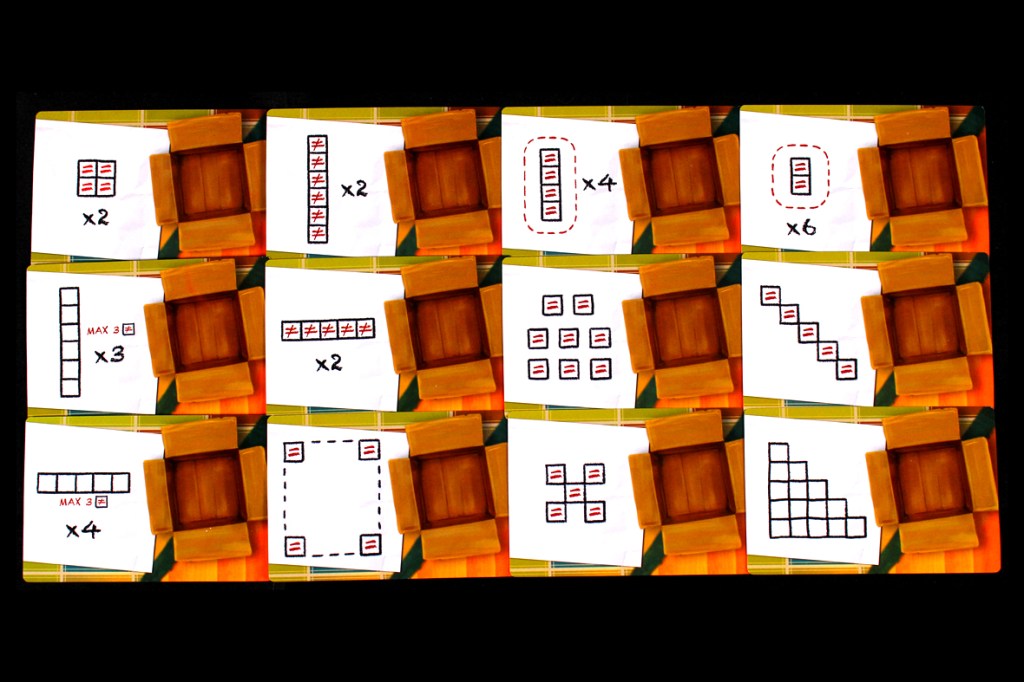
Then, place the correct number of Scoring Tokens on each card:
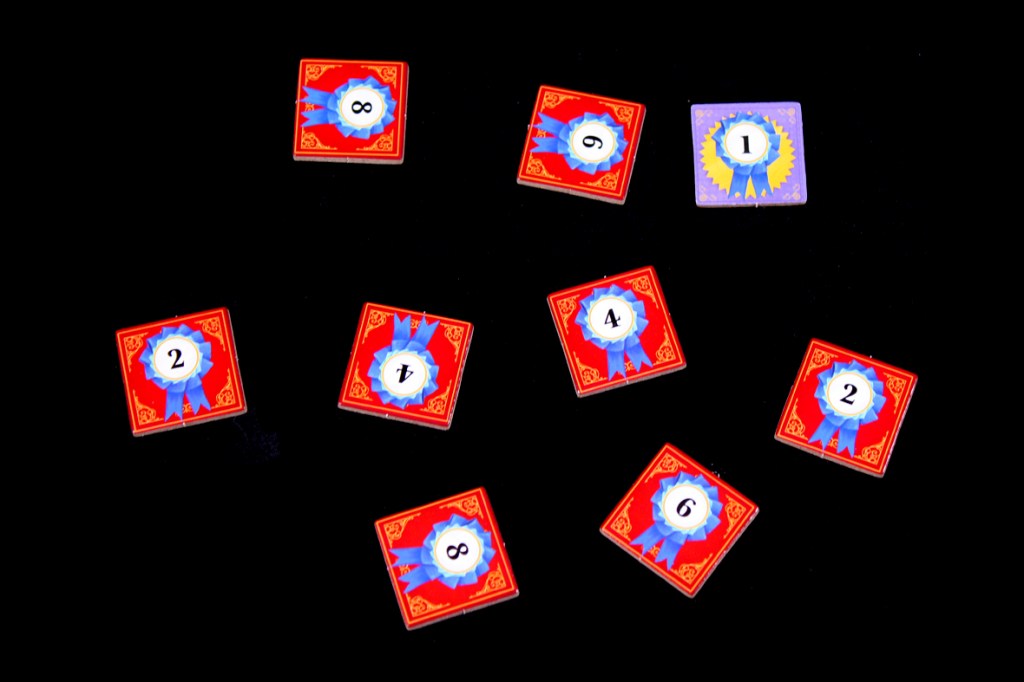
- 2 players: Use the 4 / 8.
- 3 players: Use the 4 / 6 / 8.
- 4 players: Use all Scoring Tokens.
Each player also gets a Personal Goal:
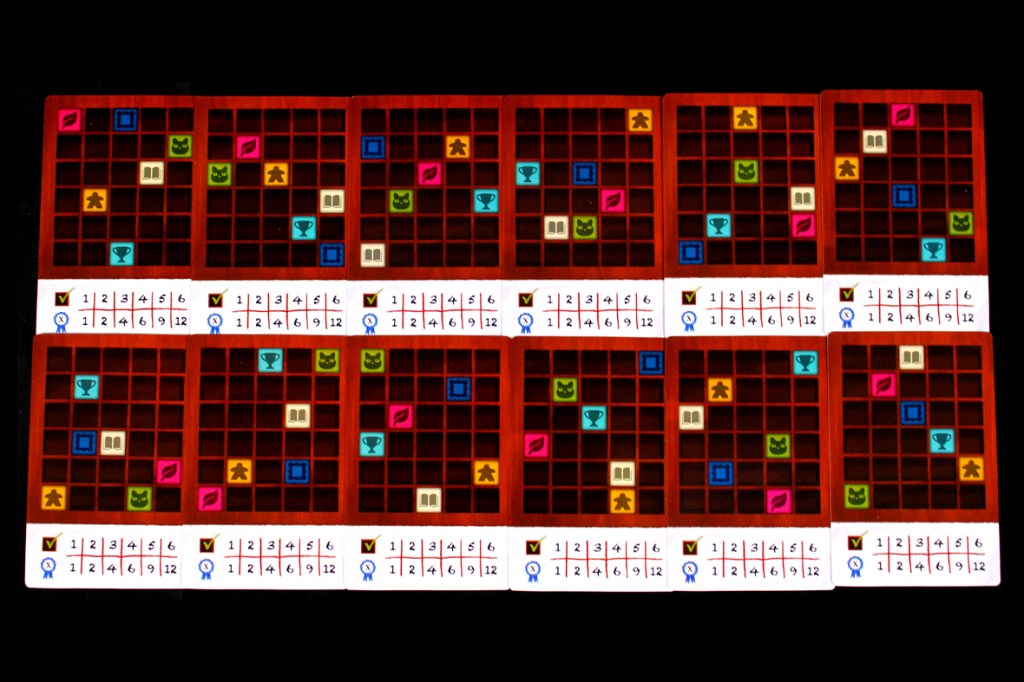
Each player gets a bookshelf, as well:
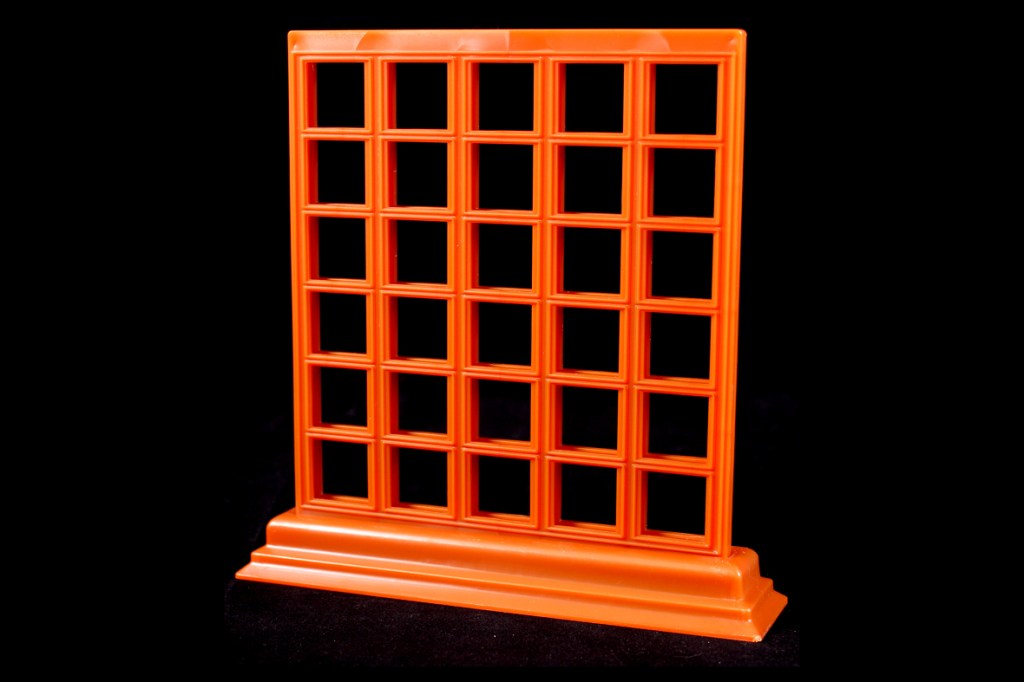
Finally, shuffle up the tiles in the bag and draw item tiles out, placing them on the Living Room Board. Don’t use spots with dots that are higher than your player count (at two, don’t place on the 3s or 4s).

You should be ready to start!
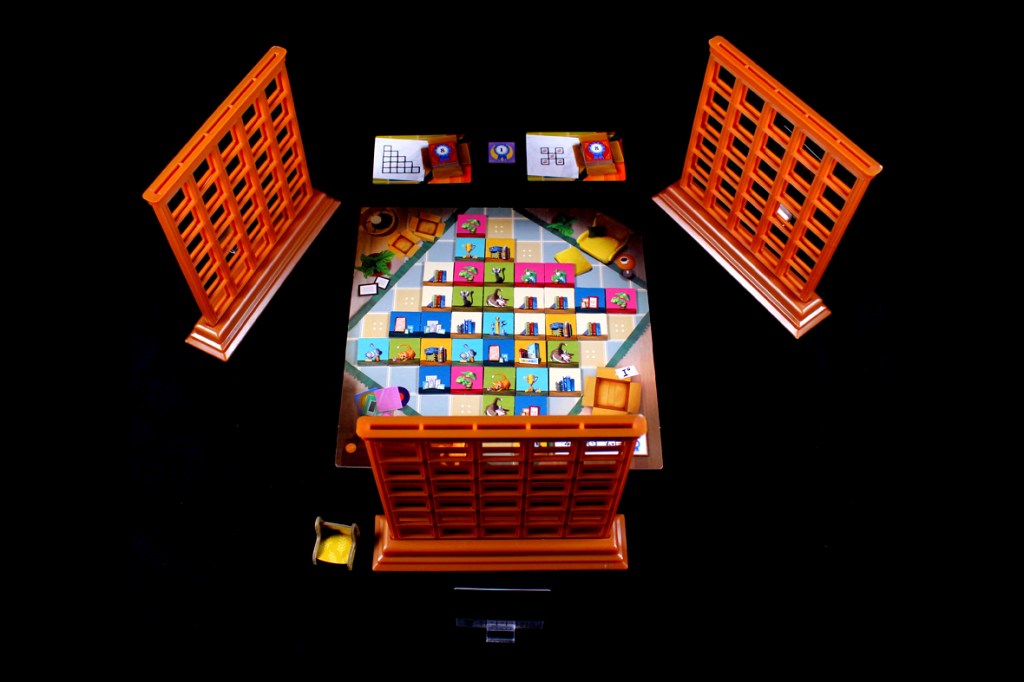
Gameplay
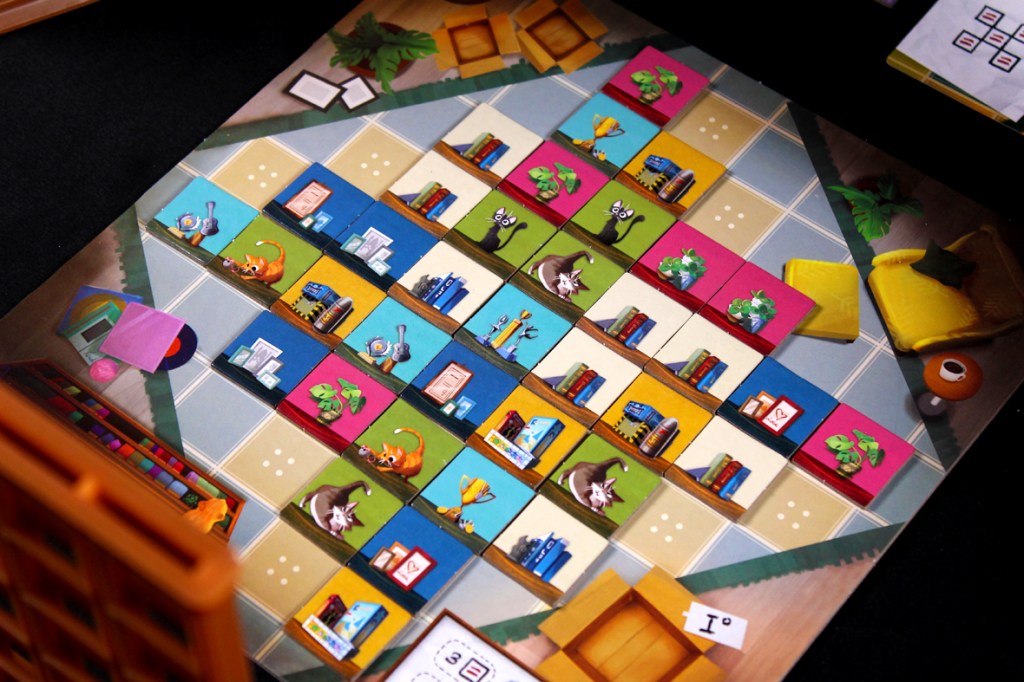
My Shelfie is a game of shelf organization! Fulfill your shelf dreams by drafting tiles and fulfilling public and private goals.
Each turn, you’ll take tiles from the Living Room Board. You can take tiles as long as:
- You take no more than three.
- You take tiles in a straight horizontal or vertical line.
- All tiles you take have at least one edge that isn’t touching another tile. Note that this means that you can’t take a tile, free up an edge on another tile, then take that tile. They have to all be free before you take any of them.
Once you’ve taken a set of tiles, you may place all of them into one column in any order you want. Note that this means you can’t take more tiles than would otherwise fit in a column.
If your turn would end and there are four or fewer tiles on the Living Room Board, you have to refill the entire Living Room Board. Draw new tiles from the bag and fill it out like you did in setup. At the end of your turn, if you fulfilled a Public Goal, take the highest-value tile remaining on the card.
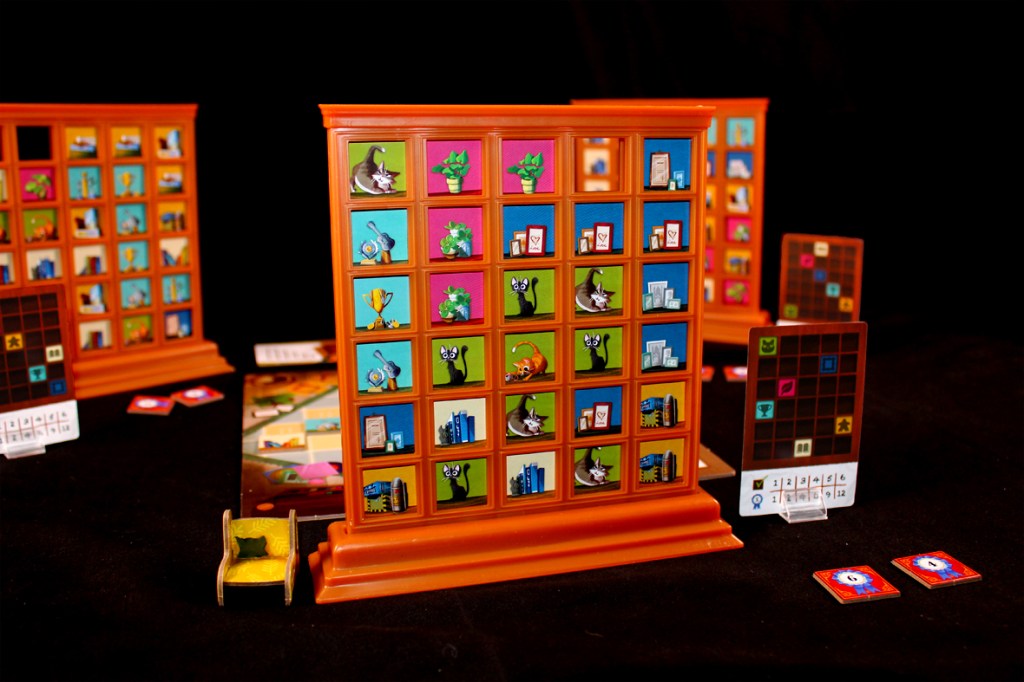
The first player to fill their bookshelf entirely takes the Game End tile; it’s worth an extra point. Once the round ends (all players have taken an equal number of turns), the game ends! Players score their Public Goals, their Private Goals, and 2 / 3 / 5 / 8 points for groups of 3 / 4 / 5 / 6+ tiles of the same color in a group. The player with the most points wins!
Player Count Differences
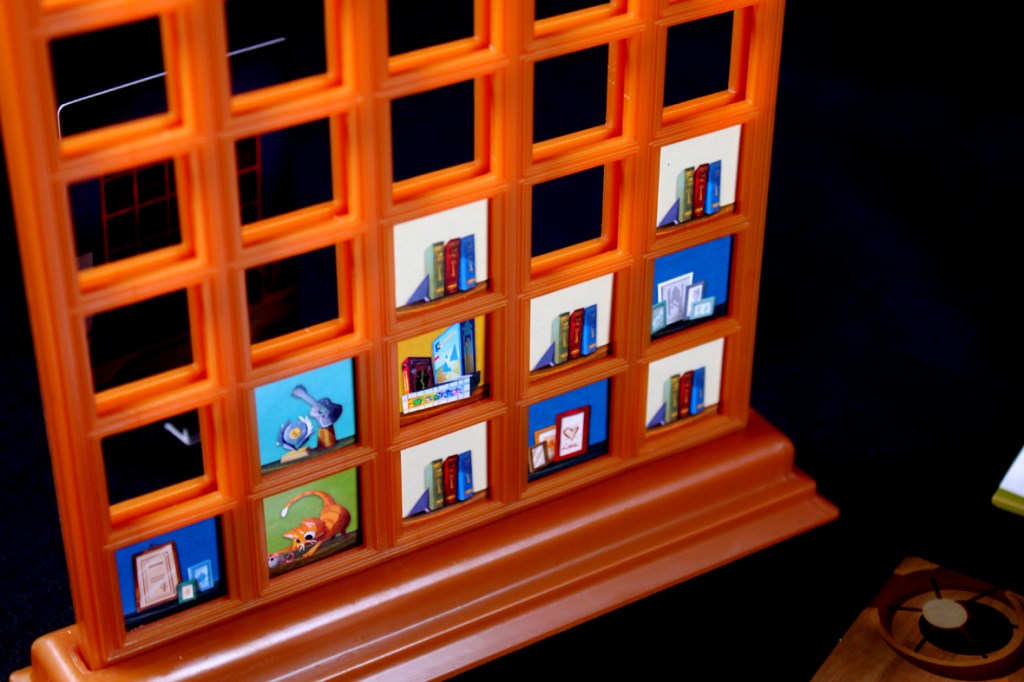
Not a ton, here! My Shelfie is, in concept, a drafting game, and those usually do a pretty good job scaling up with player count (since you can just add more tiles to draft). Here, they slightly change the shape of the board’s tile arrangement so that as you add more players, there are more tiles present and more options for drafting, which is nice. It means that the last player might yet find something they need. Plus, with the way that the public and private goals interact, it’s very possible for there to be two players who need very different things.
Strategy
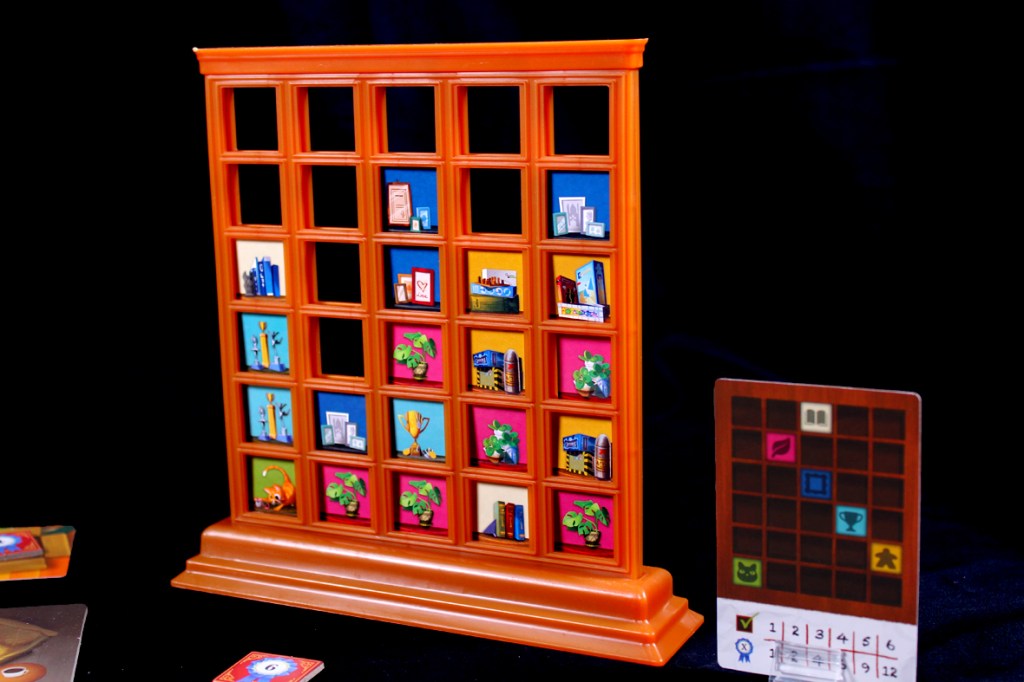
- Don’t forget about groups of the same type! That can be a lot of points. Ideally, you’d be going for six tiles of the same type connected every time, since that’s the most bang for your buck, relatively speaking (8 points for a group of six). That said, if you can’t get that, scoring for other things isn’t bad.
- Similarly, don’t overlook your private goal! That’s also a lot of points. I believe it’s 12 points for fully completing that, and that’s the thing you have ostensibly the most control over. It’s not always worth forgetting your private goal in favor of a public goal or something; often, you might as well just take the smaller point value and still get your private goal fulfilled. That said, it is somewhat easy to forget.
- Try to force another player to refill the board; that means they’ll usually have to waste a turn getting a terrible draw of tiles. The board is refilled at the end of a turn where there are four or fewer tiles remaining. In a two-player game, particularly, you can really turn the screws on a player by leaving five tiles on the board, guaranteeing that they will have to refill the board once they take a tile. With more players, you can still do this, but it relies on the player after you noticing that’s what you’re trying to do.
- You can see how players are progressing on the public goals. You may not be able to do much about that, but you can focus your moves on points elsewhere if you can’t catch up to them in time. Don’t try to race someone you can’t catch; it’s just a weird investment in something you’re not going to be able to land. If you see someone a bit too far ahead of you, maybe work on something else. You’ll be able to catch up on the public goals later on.
- As long as you accomplish the public goals eventually, you’ll still get a good amount of points. Don’t not do the public goals! They’re still worth points, even if you complete them later than other players. Getting them first is just explicitly more points.
- Try not to build too many shapes that rely on horizontal placement; that takes a lot longer to do than placing three tiles vertically (since you can grab them all on one turn). That’s just a function of how placing tiles works. You can very easily place three tiles vertically at once if you pull the right set of tiles, but it takes three turns to place three tiles horizontally. Not ideal. if you can focus on vertical plans, you can try towards that six much more quickly.
Pros, Mehs, and Cons

Pros
- As a guy who loves having shelves, this game is thematically targeted directly at me. I really like everything about shelves. And with the move impending, I need to think about what’s going on with reshelving and moving everything around. Maybe this will help? Probably not since I’m hoping not to place any cats on shelves, but we will see what we see when I get into the new space!
- I enjoy that there are cat-friendly spots you can make on the shelf. While I’m not personally a cat owner, I’m definitely a cat person, so I’m glad to see that you can make plenty of space for shelf cats. Honestly, it’s ideal since these cats can’t knock everything off of the shelf. I love our cat, but … cats, man.
- The public and private goals are nice; it’s always fun to have something to try and race towards. Having a nice mix of goals in these kinds of games is good! There’s a good variety of them, as well.
- I think the thing I like most is how the tiles are taken; it allows for some elegant blocking and also some interesting strategic choices. I think this is most of what makes the game interesting. It’s a slightly more complex tile drafting system. You’ve got a lot of options, and a lot of fun strategy in that. Do you take tiles to make progress towards your own goals? Do you split up things that your opponents need? How do you grab the tiles you need in the moment?
- I also appreciate the variety of the tiles (three different art pieces for each tile type). Keeps things from looking too samey. It would be a bit dreary if they kept the exact same tiles in their entirety, so having a bit of variety is pretty helpful. I also appreciate that the board games on the tiles are reference to other board games; it’s fun! But having a nice mix of tiles on the shelf is pretty helpful.
- A fairly quick game. I think it’s only 25 minutes when you get through it. If you understand the rules, it’s even faster. The challenge is really just resetting the board whenever you need more tiles; that takes a while.
- The verticality of the game makes for an impressive visual during and after play. It’s really cool how everything stacks up! I like the table presence of the game. Hopefully the photos do it justice for y’all.
Mehs
- I would have liked it if the shelves could fit in the box already assembled. Just a bit of a nitpick! The inside of the box ends up fairly disorganized. There’s bags and such, but it almost feels like it would have been nice if the box were a little bit larger.
Cons
- The plastic shelves are a bit finicky; watch to make sure they don’t pop apart on you. A few tiles kept popping out while I was playing, which is not ideal. Just make sure to press on the sides every now and then so that they stay together.
- The initial setup and tile-replacement is kind of a slog. This is the less-good thing about this one; placing all the tiles properly can be a bit messy. It’s the kind of thing you’d hope for a double-layered board for, just so that the pieces can stay in place. As it stands, it’s a fair number of tokens to have to place a few times a game, so it’s not … my favorite thing.
Overall: 7.25 / 10
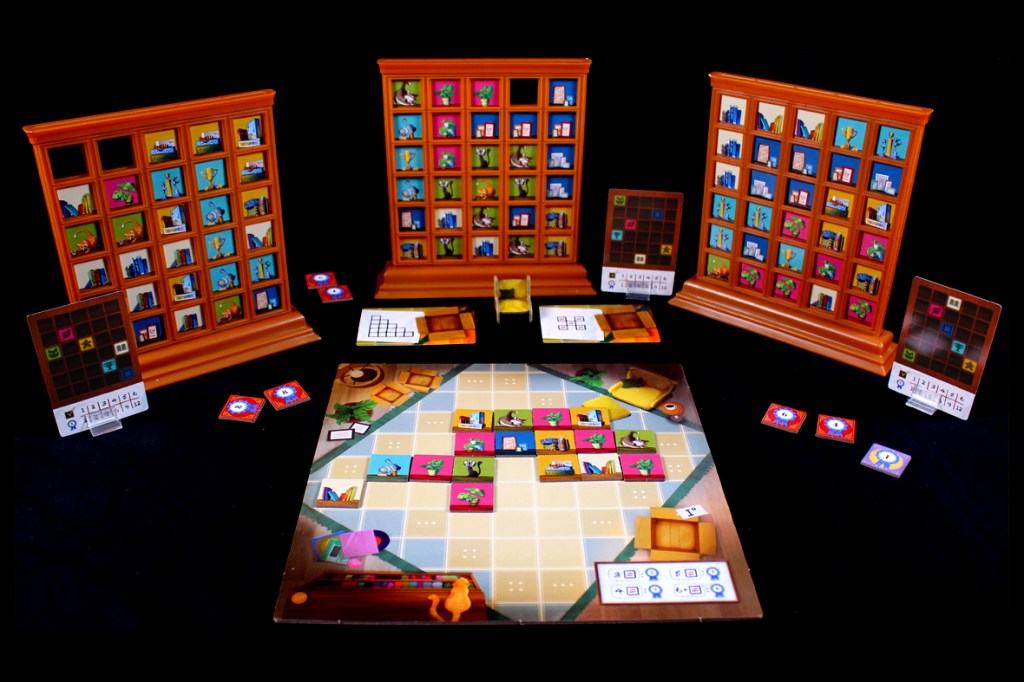
Overall, I enjoyed My Shelfie! I think it’s not likely going to make the long-term jump to my permanent collection, though, and that’s okay. For me, it’s a combination of a few things: the physical shelves are a little clunky, resetting the board takes a bit of time and is finicky, and there’s a pretty solid adaptation available on BGA already which addresses those first two things. I like a physical board game, don’t get me wrong, and I think there’s a fun spin on the Connect Four-style puzzle at play, here, but not having to deal with setup is a pretty strong vote in the Board Game Arena implementation’s favor. There may be something to the fact that I already also have plenty of real-life shelves to catalog and maintain, so the allure of doing that in a board game isn’t as compelling for me as it might have been when I only had the one. That’s more deep-cut psychological, though, so who’s to say? I do find it funny, conceptually, since it gets into the same category of meta-board games as, say, Shelfie Stacker. I wonder how much appeal they find outside of the core board gaming community. Hard to say. If you are reading this and you’re on the fence, let me at least offer the good things about the game as well. Matthew Dunstan is kind of entering a design Renaissance right now, and Phil Walker-Harding is a seasoned veteran of design, so the game, at its core, is very good. The puzzle around which pieces you grab, when to grab them, and how to place them is a solid one. For folks who grew up with a Connect Four-style game and want to play a game that isn’t … solved, this is a great strategic alternative. The game has variable personal and public goals, which I always like, and there’s a ton of interaction as players pull tiles from the center to fill up their little shelves. Big fan. It’s a clever game that doesn’t take too long to learn and is the exact right level of challenge that I can play it after a long day of work without too much trouble. That kind of casual strategy game is a great fit for me, personally; I just wish the physical implementation of the game were a bit less finicky. But if you’re looking for a casual strategy game with some verticality, the idea of keeping your shelves in order is appealing, or you just really like the word “shelfie”, My Shelfie might be right up your alley! I liked playing it.
If you enjoyed this review and would like to support What’s Eric Playing? in the future, please check out my Patreon. Thanks for reading!